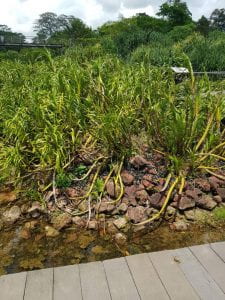Do not doubt your eyes! Tigers are in the Botanic Gardens! Well…they are not exactly the copper-coated feline that we are familiar with, but they bear similar striking golden patterns as the warm-blooded creature. We are talking about the magnificent Tiger Orchid (Grammatophyllum speciosum), the largest orchid species in the world!
Bearing immensely leafy stems and spectacular root bundles, this rhizomatic plant can grow up to heights of 3 metres, often observed as clusters weighing several hundred kilograms to a ton. Presumed to be nationally extinct due to habitat loss, it was reintroduced in Singapore in July 1999 under the Orchid Conservation Programme by the Singapore Botanic Gardens. This programme has reintroduced many other orchid species which can be found at the Orchid Islands housed at the Keppel Discovery Wetlands.

Figure 1: Tiger Orchid at the Keppel Discovery Wetlands, Singapore Botanic Gardens (Photo Credit: Kwa Siew Yen)
Back to a Time where Tigers Roam
Covering an area of 1.8-hectares, the Keppel Discovery Wetlands is a restoration project of the historical forested wetland ecosystem found within the Botanic Gardens, an area that had originally been drained by 1920 and converted into ponds. Active restoration techniques involving the planting of over 200 native plant species were implemented. Flooded conditions were restored through the construction of weirs which accumulates rainwater and water through a spring that drains into the area.

Figure 2: Location of the Keppel Discovery Wetlands (Author’s own)
Why Restore the Swampy Wetlands
0.39%. Singapore’s remaining freshwater forest wetland habitats cover only a mere 0.39% of the country’s land area, which once were 16% historically, with losses attributed to urban development. The majority of the primary wetland forests are situated at the Nee Soon Swamp—adjacent to a restricted military zone with an active firing range, restricting the public’s access to them. This project conserves the botanical wealth of Singapore’s highly endangered flora and fauna and promotes public appreciation of the native biodiversity and the benefits they bring.

Figure 3: Unique features of wetlands and their multitude of ecosystem services
(Author’s own; illustrations based on the fieldtrip to the Learning Forest)
Wetlands in Singapore are cradles of immense biodiversity, housing rich feeding and nursery grounds, while functioning as pitstops for migratory birds. Ecosystem services provided constitute an indispensable part of biogeochemical cycling by supplying essential nutrients—nitrogen, phosphorus, and sulfur—for plant growth within and beyond the wetlands. Moreover, the sequestration of carbon in plant communities aids in climate change mitigation.
Threats to the Contemporary Tigers
Safe to say, the Tiger Orchid is in the good hands of the Keppel Discovery Wetlands, protected from threats such as the illegal wildlife trade. Southeast Asia is a hot sport for the ‘invisible’ orchid trade, with over 80% of the 400 species of ornamental plants in the illegal trade consisting of wild orchids. The Tiger Orchid, alongside many others in the Orchidaceae family, such as the Bamboo Orchid, are highly sought after due to their intricate patterning and/or rarity. All members of the Orchidaceae family are listed in the Convention on International Trade in Endangered Species of Flora and Fauna (CITES). However, their trade has been largely neglected by official government databases, simply because horticulture fails to appeal to the masses emotionally in the way that most animals do. More importantly, there appears to be a general dissonance between ‘poaching’ and ‘plants’, thereby causing species exploitation to fly under the radar.

Figure 5: Bamboo Orchid (Arundina graminifolia) (Photo Credit: Kwa Siew Yen)
If Not Now, When?

Figure 5: Yellow and brown stripes of a flowering Tiger Orchid (Photo Credit: NParks, 2021)
Although addressing the illegal trade requires regional and international collaborative actions given its transboundary nature, we can dampen the demand through conscious consumption. Avoiding the purchase of threatened and endangered plants is imperative as these plants are likely to be sourced from the wild and often indiscriminately.
Written by: Kwa Siew Yen

Leave a Reply